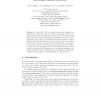555 search results - page 22 / 111 » From ABZ to Cryptography |
CHES
2009
Springer
14 years 10 months ago
2009
Springer
Tamper-proof devices are pretty powerful. They can be used to have better security in applications. In this work we observe that they can also be maliciously used in order to defea...
TCC
2009
Springer
14 years 10 months ago
2009
Springer
Various results show that oblivious transfer can be implemented using the assumption of noisy channels. Unfortunately, this assumption is not as weak as one might think, because i...
STOC
2005
ACM
14 years 10 months ago
2005
ACM
Assume that Alice and Bob, given an authentic channel, have a protocol where they end up with a bit SA and SB, respectively, such that with probability 1+ 2 these bits are equal. ...
PKC
2007
Springer
14 years 4 months ago
2007
Springer
At PKC 2003 Paeng, Jung, and Ha proposed a lattice based public key cryptosystem(PJH). It is originated from GGH, and designed as a hybrid of GGH and NTRUEncrypt in order to reduce...
PKC
2005
Springer
14 years 3 months ago
2005
Springer
To sign with RSA, one usually encodes the message m as µ(m) and then raises the result to the private exponent modulo N. In Asiacrypt 2000, Coron et al. showed how to build a secu...

